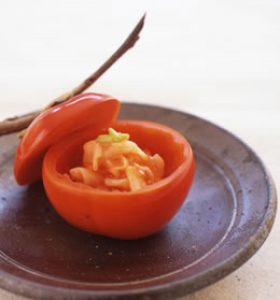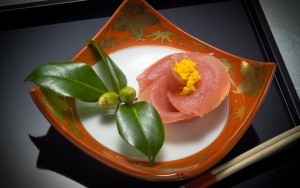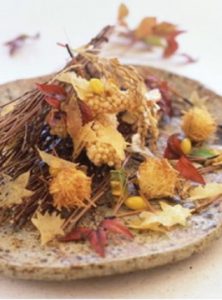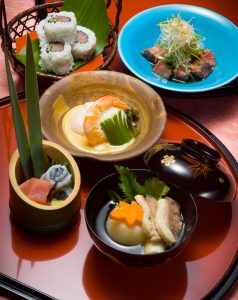We can’t stress enough the importance of Japanese food presentation to our cooking class students. It’s not difficult, but you need to throw out your ideas of western food presentation first. Here are some things to consider when arranging food the Japanese way:
1. Uniformity vs. Contrast
While in the west, food is presented on uniform round plates, Japanese food is served on a variety of dishes–different shapes, colours, textures, sizes. How dishes are chosen is a topic for a whole thesis, but seasonality is important, and the overall feel of the dish itself–contrasting colours (like red tuna on clear white porcelain) or textures (delicate sashimi on rustic pottery). And each course is served in a different dish–the more variety the better.
2. Asymmetry
Uniformity often presupposes symmetry–western dishes are served with symmetry in mind. But the Japanese prefer to arrange things slightly askew, and using height and contrast which adds tension and drama to the arrangement.
3. Five Colours
Red, White, Green, Black, Yellow is always present in each arrangement. Not only does this combination seem naturally pleasing to the eye, it is also a good way to ensure the overall healthiness of your dish–each colour represents vitamin and mineral content (Vitamin A for red and C for yellow for example).
4. Importance of Empty Space
Think Zen when presenting Japanese food. It’s O.K. to pile food up high, but not flat to cover a dish or plate. A lot of negative space is considered to whet the appetite–and in the summer, more empty space is better for a cooling feeling, while in winter, you can be more generous with your arrangement. Try it and see how it feels. Negative space is a design aesthetic that often needs to be learned, especially in the west where we think more is always better.
5. Seasonality
In all Japanese food, but especially in Kaiseki, seasonality is important. Even in the average home, the cherry blossom chopstick rest appears in the spring–and Kaiseki can feature real blossoms as garnish. It’s hard to comprehend perhaps in Australia,where the change of seasons is not as pronounced as some northern hemisphere countries. But seasonality is a key cornerstone of food aesthetics in Japan.
There’s also a whole bunch of don’t do rules including never arrange four elements on a plate as the Japanese word for four is a homonym for death. Many rules pertain to the way fish is presented–ocean fish should be presented with the head to the left, and the backbone at the top of the plate, small fish should be presented with the backbone towards you, because you don’t want the sliced stomach facing you (too reminiscent of harakiri).
The following beautiful books are also worth exploring:
The Aesthetics of the Japanese Lunchbox by Kenji Ekuan, Translated by Don Kenny, The MIT Press.
The Fine Art of Japanese Food Presentation by Yoshio Tsuchiya, Kodansha Internatinal
by Masako Fukui, Copyright Kei’s Kitchen





